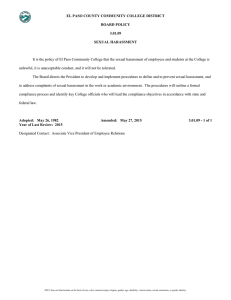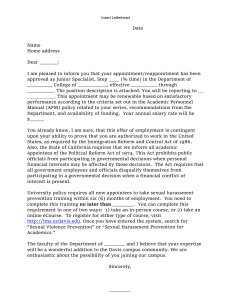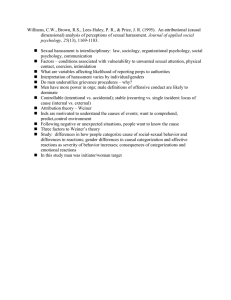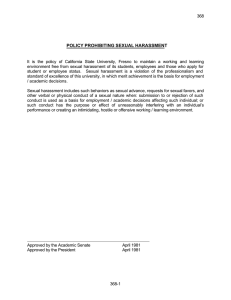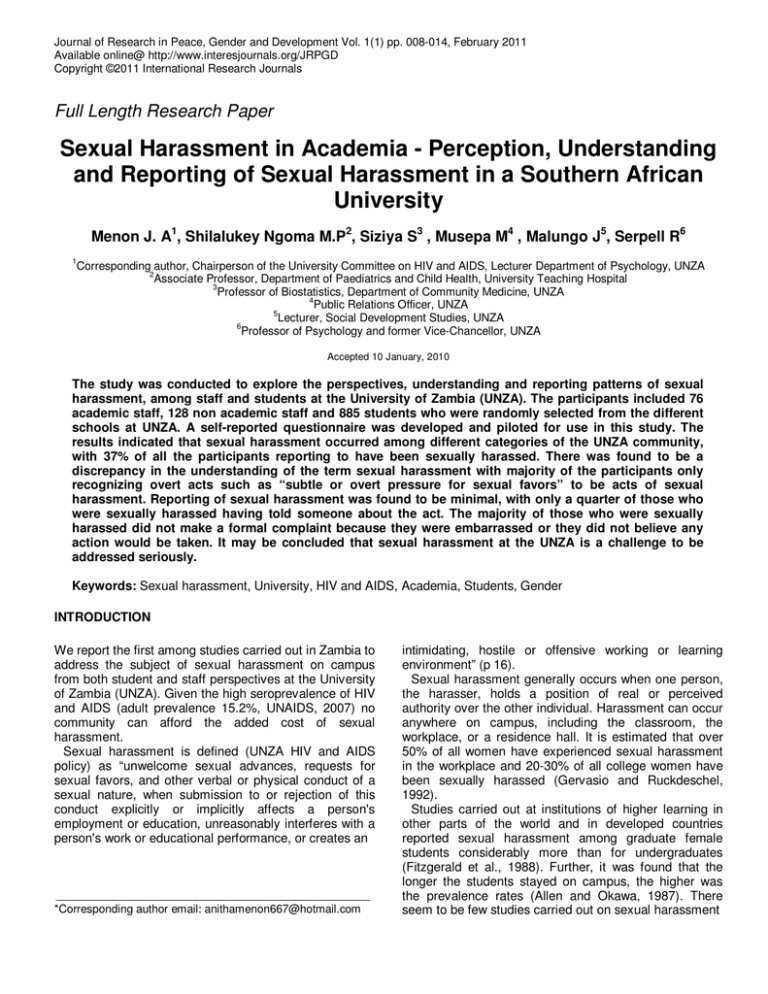
Journal of Research in Peace, Gender and Development Vol. 1(1) pp. 008-014, February 2011
Available online@ http://www.interesjournals.org/JRPGD
Copyright ©2011 International Research Journals
Full Length Research Paper
Sexual Harassment in Academia - Perception, Understanding
and Reporting of Sexual Harassment in a Southern African
University
Menon J. A1, Shilalukey Ngoma M.P2, Siziya S3 , Musepa M4 , Malungo J5, Serpell R6
1
Corresponding author, Chairperson of the University Committee on HIV and AIDS, Lecturer Department of Psychology, UNZA
2
Associate Professor, Department of Paediatrics and Child Health, University Teaching Hospital
3
Professor of Biostatistics, Department of Community Medicine, UNZA
4
Public Relations Officer, UNZA
5
Lecturer, Social Development Studies, UNZA
6
Professor of Psychology and former Vice-Chancellor, UNZA
Accepted 10 January, 2010
The study was conducted to explore the perspectives, understanding and reporting patterns of sexual
harassment, among staff and students at the University of Zambia (UNZA). The participants included 76
academic staff, 128 non academic staff and 885 students who were randomly selected from the different
schools at UNZA. A self-reported questionnaire was developed and piloted for use in this study. The
results indicated that sexual harassment occurred among different categories of the UNZA community,
with 37% of all the participants reporting to have been sexually harassed. There was found to be a
discrepancy in the understanding of the term sexual harassment with majority of the participants only
recognizing overt acts such as “subtle or overt pressure for sexual favors” to be acts of sexual
harassment. Reporting of sexual harassment was found to be minimal, with only a quarter of those who
were sexually harassed having told someone about the act. The majority of those who were sexually
harassed did not make a formal complaint because they were embarrassed or they did not believe any
action would be taken. It may be concluded that sexual harassment at the UNZA is a challenge to be
addressed seriously.
Keywords: Sexual harassment, University, HIV and AIDS, Academia, Students, Gender
INTRODUCTION
We report the first among studies carried out in Zambia to
address the subject of sexual harassment on campus
from both student and staff perspectives at the University
of Zambia (UNZA). Given the high seroprevalence of HIV
and AIDS (adult prevalence 15.2%, UNAIDS, 2007) no
community can afford the added cost of sexual
harassment.
Sexual harassment is defined (UNZA HIV and AIDS
policy) as “unwelcome sexual advances, requests for
sexual favors, and other verbal or physical conduct of a
sexual nature, when submission to or rejection of this
conduct explicitly or implicitly affects a person's
employment or education, unreasonably interferes with a
person's work or educational performance, or creates an
*Corresponding author email: anithamenon667@hotmail.com
intimidating, hostile or offensive working or learning
environment” (p 16).
Sexual harassment generally occurs when one person,
the harasser, holds a position of real or perceived
authority over the other individual. Harassment can occur
anywhere on campus, including the classroom, the
workplace, or a residence hall. It is estimated that over
50% of all women have experienced sexual harassment
in the workplace and 20-30% of all college women have
been sexually harassed (Gervasio and Ruckdeschel,
1992).
Studies carried out at institutions of higher learning in
other parts of the world and in developed countries
reported sexual harassment among graduate female
students considerably more than for undergraduates
(Fitzgerald et al., 1988). Further, it was found that the
longer the students stayed on campus, the higher was
the prevalence rates (Allen and Okawa, 1987). There
seem to be few studies carried out on sexual harassment
Menon et al 009
in Zambia, but there are studies carried out in the region.
A report on ‘Researching the implementation of Sexual
harassment policies in three Universities in Southern
Africa’ (coordinated by the African Gender InstituteUniversity of Cape town) includes narrations on Zambia
(2005). It refers to a national gender policy that was
instituted in 2000. This is restricted in relation to sexual
harassment and gender based violence. Emphasis is
placed on sexual harassment at the work place, leaving
out other stakeholders. Many women have to give in to
sexual advances in order to secure work. Most of these
cases go undocumented, little research has been done
on these cases.
Sexual harassment can have various consequences for
both students and staff. For example, students who
experience sexual harassment are likely to change their
major subject choices, alter career plans or avoid the
threatening situation (Schneider et al. 1997) and the
harassed academic staffs are likely to experience
strained work relations and become generally unsatisfied
with their jobs (Dev et al., 1996) which may impede their
academic careers (Schneider, 1987). For this reason, it
would be pertinent to address this issue in academia.
Thus, following a number of informal complaints from
UNZA students about sexual harassment, this study was
conducted to explore this issue in the interest of
protecting the rights of all.
were targeted (216 staff); questionnaires were received
back from 76 staff, giving a response rate of 35.2%.
Twenty-five percent of the non-academic staffs at UNZA
were targeted (294 academic staff) and the
questionnaires were received back from 128, giving a
response rate of 43.5%.
Research Instruments
A self-administered questionnaire consisting of both of
semi-structured open questions as well as closedquestions was developed and piloted. The questionnaire
included questions about perception and understanding
of sexual harassment.
Procedure
This baseline survey obtained cross-sectional data from
all fourteen schools at UNZA from students, academic
and non-academic members of staff. Research assistants
met students in the classes and distributed selfadministered questionnaires, which were collected within
one month. Academic and non-academic members of
staff as well as the Deans were contacted.
Questionnaires were left with staff and Deans. The
research assistants later collected the completed selfadministered questionnaires.
Aim of the Study
The study explored the perspectives, understanding and
reporting patterns of sexual harassment, among staff and
students at the UNZA.
METHODOLOGY
Participants
Participants included students, academic and nonacademic staff at UNZA during the academic year 20062007. All the students, by year of study, were given the
chance to participate in the sample. For the academic
and non-academic members of staff, schools and
departments were used as the sampling strata. At least
two academic and two non-academic members of staff
were selected from the departments. Deans, Directors
and Heads of Department also participated in the study.
Response rate
Of the 2003 students (25%) targeted, questionnaires
were received back from 855 students, giving a response
rate of 44.2%. Two staff members from each department
Data Management and Processing
The data was managed by a trained data expert. Only
the complete questionnaires were immediately used. The
data was analyzed using SPSS and EPI. Since none of
the measures where normally distributed, Kruskal Wallis
and Mann-Whitney were used to make inter-group
comparisons.
Ethical considerations
Approval was obtained from the Research Ethics
Committee at the University of Zambia prior to the
commencement of the research. An informed verbal
consent was obtained from the participants prior to their
participation.
Confidentiality was observed and
participants were free to withdraw from study at any time.
Consent and institutional support were obtained from
Vice-Chancellor and Deputy Vice Chancellors’ offices.
Permission to meet the students in class and distribute
questionnaires was also obtained from their lecturers.
J. Res. Peace Gend. Dev. 010
RESULTS
Profile of participants
The study included a total of 1089 participants, aged from
20 to above 45 years, from different categories within the
confines of the University. The different categories
included 76 academic members of staff, 128 non
academic members of staff and 885 students.
Participants had spent from less than one year to above
five years at UNZA.
Among the76 academic members of staff who
participated, 70% (49) were males and 30 %( 21) were
females while 8 %( 6) did not indicate their sex. The
majority of participants (64.5%) in this category were
aged above 45 years while the rest (22%) were between
40-44 years off age. Majority of participants in this
category had spent more than five years at UNZA.
The non academic category had 128 participants.
Among the non academic staff who participated in the
study, the majority, (65.5%) were female staff and the
rest were males (26.6%). The great number of
participants in this category was in the age range 35-39
years. There were more females in this category.
Eight hundred and eighty five students from the different
schools at UNZA participated in the study. The majority of
the students were in their 3rd and 4th year of study (21.7%
for both) and about 19% had spent less than a year at
UNZA. The age range was 20-24 years for most of the
students (55.4%) while the rest were in the ranges 25-29
years (19.4%), less than 20 years (10%), 30-34 years
(8.8%), 35-39 years (2.7%), 40-44 years (0.8%) and
above 45 years (0.5%) respectively. There were more
female student participants (47.7%) than males (43.3%).
Seven percent (7%) of the student participants did not
indicate their sex. However, the sex difference was not
significant (p=0.42).
Perception and Understanding of Sexual Harassment
The following modalities were studied: perception of
UNZA environment, levels of worry about being sexually
harassed as well as levels of knowledge and
understanding. The category to which the participant
belonged to at UNZA had a bearing on the perception of
sexual harassment (table 1 and 2).
(a) Perception of the Environment at UNZA
The measured responses included whether the
participants
found
the
University
environment
“welcoming, challenging, supportive, exciting, unsafe,
hostile, stressful and or intimidating”.
All three categories showed a significant difference in
their perceptions. The inter group comparison revealed a
significant difference in perception. When compared to
the students, the non-academic staff perceived the
environment to be more hostile (Z=-3.34, p<0.01), unsafe
(Z=-2.89, p<0.01) and intimidating (Z=-3.07, p<0.01) .
The non academic staff also found the environment to be
more hostile than the academic staff (Z=-3.35,
p<0.01).The
students,
however,
perceived
the
environment as supportive compared to the non
academic staff (Z=-4.27, p<0.01).
All three groups showed a significant difference in their
responses to “understanding of sexual harassment”.
Compared to the academic staff, more students
understood, repeated humiliation based upon the sex
(Z=-3.60, p<0.01), remarks about sexual activities (Z=4.39, p<0.01), exposure to sexually suggestive visual
displays (Z=-4.23, p<0.01), persistent, unwanted sexual
attention (Z=-4.11, p<0.01), physical interference with
individuals (Z=-3.84, p<0.01) and overt pressure for
sexual favors (Z=-3.46, p<0.01), and explicit statements
(Z=-3.78, p<0.01 ) to be acts of sexual harassment
.Compared to academic staff,
non-academic staff
understood unwanted sexual attention (Z=-3.56, p<0.01),
subtle pressure for sexual favors (Z=-2.72, p<0.01, and
intentional touching (Z=-2.93, p<0.01 ) to constitute acts
of sexual harassment.
The majority of the respondents (98%) expressed
knowledge of what sexual harassment is. However, when
segregated by sex, results show that, all the female
academic staff (100%) interviewed indicated that they
understand what sexual harassment is compared to 88%
of the male academic staff. Eighty four percent (84%) of
the non-academic staff reported that they knew what
sexual harassment is. There was no significant gender
difference in this response (p=0.80). Among students,
majority of them (74.4%) reported that they knew what
sexual harassment is. There was almost no gender
difference to this response, 72.3% female students and
76.3% male students reported they knew what sexual
harassment was. However, more female students
reported that they did not know what sexual harassment
was.
Reporting of sexual harassment
Participants were asked whether they had been sexually
harassed and if they reported such acts.
Few sexually harassed participants were free to share
the problem with anyone. Overall, 67.4 % of the
respondents indicated that sexual harassment had not
occurred to them. It was found that 32.6% of the
respondents had experienced sexual harassment. Of all
those who had experienced it, close to one-in-four (24.5
%) of the respondents indicated that they had told
someone about it.
Menon et al
011
Table 1. Perception of the environment at UNZA
Role at UNZA
Mean
X2
p-value
Student
Academic Staff
Non-academic Staff
515
513
554
11
p=0.004*
Student
Academic Staff
Non-academic Staff
511
528
568
10
p=0.008*
Student
Academic Staff
Non-academic Staff
534
493
456
19
p=0.000*
Student
Academic Staff
Non-academic Staff
512
547
553
11
p=0.003*
Hostile
Intimidating
Supportive
Unsafe
*P<0.05
Table 2. Understanding of sexual harassment
Acts considered to be sexual harassment in UNZA HIV
and AIDS policy
Explicit or implicit propositions to engage in sexual activity
Explicit statements, jokes, anecdotes or remarks of sexual
nature
Deliberate, repeated humiliation or intimidation based upon the
sex
Remarks about sexual activities or speculations about sexual
experience
Exposure to sexually suggestive visual displays such as
photographs,
Persistent, unwanted sexual or romantic attention
Deliberate physical
individuals
interference with or
Subtle or overt pressure for sexual favors
Intentional touching or physical assault
*P<0.01
restrictions of
Role at UNZA
Student
Academic staff
Non academic staff
Student
Academic staff
Non academic staff
Student
Academic staff
Non academic staff
Student
Academic staff
Non academic staff
Student
Academic staff
Non academic staff
Student
Academic staff
Non academic staff
Student
Academic staff
Non academic staff
Student
Academic staff
Non academic staff
Student
Academic staff
Non academic staff
Mean
525.86
458.92
522.37
539.48
428.42
458.20
539.75
404.13
469.85
544.13
435.39
426.78
532.75
414.66
505.67
527.86
422.05
530.64
534.53
439.21
481.69
531.81
422.58
506.90
512.92
480.03
587.63
X2
p
4.61
0.01
22.19
0*
25.63
0*
44.67
0*
17.38
0*
14.97
0
16.09
0*
14.94
0.001*
12.69
0.002*
J. Res. Peace Gend. Dev. 012
DISCUSSION
Academic institutions have the mandate to provide
working and learning environments where work and
studies can be persuaded without fear or intimidation and
existence of sexual harassment in contrary to this
mandate. Sexual harassment in academia and workplace
has received a lot of attention (Whatley and Wasieleskie,
2001; Fitzgerald et al., 1988; Murrell et al., 1995). It has
been suggested that 19-60% of women reported some
form of sexual harassment (Fitzgerald et al., 1988) and
that sexual harassment had a negative impact on the
victims. Fitzgerald et al. (1988) reported that anxiety,
depression and physical problems are experienced by
victims of sexual harassment. The present study offers a
perspective to understanding the issue of sexual
harassment in a Southern African University.
Quid Pro Quo is a Latin phrase meaning this for that or
something for something. Exchange between parties may
take place where one is asked to provide sexual favors in
return for something else. In academia, sexual
harassment is likely to take this form. Examples include
provision of sexual favors in exchange for grades,
inclusion in activities and scholarships (bursaries).
Among the students who were brave enough to approach
the UNZA-HIV response, some were students whose
lecturers wanted sex in exchange for “change of
discipline”, or better grades in the subject taught.
Informal complaints of this nature can be looked at and
understood clearly in the light of the findings of the
present study
In academia, as in other environments victims of sexual
harassment in most cases are women, though men have
been target to harassment too (Dey et al., 1996). This
was evident in our study too. More female academic staff
reported having been harassed commpared to for their
male counterparts. Studies have shown that
consequences of sexual harassment, even at low levels,
include impaired psychological well-being resulting in
lowered self-esteem, nervousness, irritability and anger
(Popovich, 1988). Therefore it is likely that that may hold
true for the students and staff at UNZA.
Perception and Understanding of Sexual Harassment
Results of the present study indicated that about a
quarter of the participants were not sure about the
occurrence of sexual harassment at UNZA. This could be
because of perceptions that the participants do not
recognize some of the acts that constitute sexual
harassment. The non-academic staff perceived the
environment to be hostile, unsafe and intimidating,
however the students perceived the environment as
supportive.
We also found a significant difference in understanding
what constitutes sexual harassment among the
categories. The students better understood explicit
statements, repeated humiliation based upon the sex,
remarks about sexual activities, exposure to sexually
suggestive visual displays, persistent, unwanted sexual
attention, physical interference with individuals and overt
pressure for sexual favors to be sexual harassment,
where as non-academic staff better understood unwanted
sexual attention, subtle pressure for sexual favors, and
intentional touching to constitute sexual harassment.
However, a majority of the participants, considered
deliberate, repeated humiliation or intimidation based on
sex; persistent, unwanted sexual or romantic attention;
subtle or overt pressure for sexual favors; and intentional
touching or physical assault, to be acts of sexual
harassment. Only a small percentage of the respondents
considered remarks about sexual activities, or
speculations about sexual experience and deliberate
physical interference with or restrictions of individuals, to
be acts of sexual harassment. This may suggest the
need for a deliberate policy to address sexual
harassment. With a sexual harassment policy that is
widely circulated the academic community will be able to
understand that the university will not tolerate sexual
harassment and know that sexual harassment is illegal
and is against policy. They will also know where to get
professional help.
According to Stein et al (1994), flirting is very different
from sexual harassment. Flirting feels good: sexual
harassment does not. If the other person feels the same
way then a mutual attraction exists. Flirting and joking are
two-sided, and are usually enjoyable for both people.
Sexual harassment is not enjoyable—it is bullying. (Stein,
Nan ,1994). On the other hand when something offends
the person, then it may be sexual harassment. However,
sexual harassment is not a hug between friends, mutual
flirtation or sincere and personal compliments (Monroe,
1999) and therefore these normal relations should
continue. This stresses on the importance of sensitizing
the UNZA community, about sexual harassment
Reporting of Sexual harassment
Although the incidence of sexual harassment was also
high among females non-academic staff, surprisingly
none of the participants made a formal report about the
harassment. This was in concordance with a
Zimbabwean study (Zindi, 1994) in which all female
participants (3500), complained of sexual harassment but
93% indicated that they could not report sexual
harassment.
When subjected to sexual harassment only few
academic staff made formal complaints and no action
was taken based on their complaint. The most frequently
reported reason by all category of participants for not
making a formal complaint were ‘being embarrassed’ and
‘not expecting any action to be taken’. This finding is
Menon et al
similar to findings of other studies (e.g. Whatley and
Wasieleskie, 2001) which described underreporting of
sexual harassment in academia.
Although gender role seems not significant, the
university must put up measures to protect both men and
women in the working and learning environment, and
ensure that the environment is conducive to learning.
Rather than reinvent the wheel, UNZA can learn from
others. In order to achieve the objectives of the University
Policy on Sexual Harassment, the University should like
others have done, commit itself to:
• Develop preventative educational programmes
directed towards students and staff.
• Provide appropriate support and confidential
counseling in cases of sexual harassment.
• Establish and implement procedures to deal
effectively with alleged cases of sexual harassment. This
would include procedures for reporting, documentation,
mediation, investigation and liaison with existing
university disciplinary authorities. (Bayly, 1990).
The UNZA definition does not directly include visual
aspect of sexual harassment. If included or integrated in
the UNZA definition of sexual harassment, this might
increase the number of cases being reported. However,
as long as there is no complaint procedure instituted and
there is no guarantee of confidentiality, minimum cases of
sexual harassment will be reported.
Would-be offenders may sometimes be highly
respected faculty members. The university has an
obligation towards its students and also towards staff, to
provide an environment free from sexual harassment, in
keeping with rules and regulations of an “equal
opportunity” environment at UNZA. In a study done at
four of Nigeria’s universities, students identified sexual
harassment as being among stressors hindering
academic work (Ladebo, 2001). It is, however,
everyone’s responsibility i.e. both staff and students, not
to make themselves easy prey to harassers. According to
a research carried out at the university of Natal, in the
Republic of South Africa, vulnerability to sexual
harassment appeared to be associated with being alone,
provocative dressing, attractive or being under the
influence of alcohol.
Persons who find others’ behavior offensive should act
respond appropriately towards stopping it. However,
some find it difficult to speak up. This may require asking
the offender to stop, or asking someone in authority for
help. The fact that someone did not intend to sexually
harass an individual is generally not considered defense
to a complaint of sexual harassment. In most cases it is
the effect and characteristics of the behavior, not the
intent of the person who is alleged to have harassed, that
determines whether the behavior constitutes sexual
harassment (David et al., 2008). Some find jokes with a
sexual content to be sexually harassing, while others see
sexual jokes to be part of normal interaction in the work
or school setting (Baird, et al., 1995). The inclusive
013
definition of both verbal and action by the UNZA HIV and
AIDS policy is a safeguard for the victim. It up to the
University therefore to provide a safe environment for the
students to learn.(Gunning- Schepers, 2005). Programs
to sensitize staff and students on sexual harassment are
essential at the University of Zambia. According to
Monroe (1999), College and Universities impose unique
expectation and opportunities. They must lead by
example in eliminating gender inequities among all
segments of the academic community. They also have
the important opportunity to shape the future by forging
an ethos of equity and care (Monroe, 1999)
Limitations of the study
Although several conclusions could be drawn from the
results of this study suggesting the need to deal with
sexual harassment at the University of Zambia, we need
to be careful when considering such conclusions. The
results of the study may have been affected by various
limitations such as the low response rates which may
have influenced the patterns of the results and over
estimation of sexual harassment. Earlier researches
indicate that low response rate is often accompanied by
an increased number of participants reporting sexual
harassment (Gruber, 1990). It must also be
acknowledged that personal characteristics of the
participants may have had some influence on their
responses. It was not possible for us to assess if there
were any significant differences in the characteristics of
those who participated and did not participate in this
study due to the confidential nature of the study.
.
CONCLUSION
The problem of sexual harassment at UNZA should not
be underestimated. The results indicate that the
environment at UNZA does not allow complaints about
sexual harassment. Definite measures for dealing with
complaints need to be put in place, so that when a formal
complaint is made, the complainants will have access to
redress. Ongoing education of those who harass others
and their victims is important. UNZA needs a distinct
institutional policy and action plan on sexual harassment.
A clear mechanism of complaints and regulatory
procedures for both students and staff should be in place.
We presume that Zambia is certainly not the only country
with this challenge, especially in the era of HIV and AIDS.
Awareness creation and education of all sectors of the
community is expected to bear positive results in
reducing the occurrence of sexual harassment among
academia.
J. Res. Peace Gend. Dev. 014
REFERENCES
African Gender Institute-University of Cape Town (2005) Researching
the implementation of Sexual harassment policies in three
Universities in Southern Africa’.
Allen D, Okawa JB (1987). A counseling center looks at harassment. J.
NAWDAC. 51: 9-16.
Baird CL, Bensko NL, Bell PA, Viney W, Woody WD (1995). Gender
influence on perceptions of hostile environment sexual harassment.
Psychol. Rep. 77: 79-82.
Bayly S (1990). Meritor and Related Cases. Synthesis: Law Pol. High.
Educ.114-119.
David A (2008). Canadian Journal of Behavioural Science/Revue
Canadienne des Sciences du comportemen. 39(2):110-118.
Dey EL, Korn JS, Sax LJ. (1996). Betrayed by the academy: The sexual
harassment of women college faculty. J. High. Educ. 67: 149-173.
Fitzgerald LF, Shullman SL, Bailey N, Richards M, Swecker J, Gold Y,
Ormerod M, Weitzman L (1988). The incidence and dimensions of
sexual harassment in academia and the work place. J. Vocat. Behav.
32:152-175.
Gervasio AH, Ruckdeschel K (1992). College students’ judgements of
verbal sexual harassment. J. Appl. So.l Psychol. 22:190-211.
Goldstein SE, Malanchuk O, Davis-Kean PE, Eccles JS (2007). Risk
factors of sexual harassment by peers: A longitudinal investigation of
African American and European American adolescents. J. Res.
Adolesc.17(2):285-300.
Gruber JE (1990). Methodological problems and policy implications in
sexual harassment research. Populat. Res. Pol. Rev. 9: 235-254.
Gunning-Schepers LJ (2005). Behaviour that exceeds the limits.
Nederlands Tijdschrift voor Geneeskunde.149(14): 735-736.
Ladebo OJ (2001).Appraisal of institutional performance of selected
universities offering agriculture in southern Nigeria. Unpublished PhD
thesis in the Department of Agriculture, University of Ibadan, Nigeria.
McCormack A (1985). The sexual harassment of students by teachers:
The case of students in science. Sex Roles.13: 21-32.
Monroe DV (1999). County Board of Education. 526 U.S. 629.
Popovich PM (1988) Sexual Harassment in Organizations. Employee
Responsibilities and Rights Journal. Pp. 16-20.
Schneider
KT, Swan S, Fitzgerald LF (1997). Job-related and
psychological effects of sexual harassment in the work-place:
Empirical evidence from two organizations. J. Appl. Psychol. 82(3):
401-415.
Schneider BE (1987). Graduate women, sexual harassment, and
university policy. J. High. Educ. 58(1): 46-65.
Stein N, Sjostrem L (1994). Flirting or Hurting: A Teacher's Guide to
Sexual Harassment Washington: NEA Professional Library.
University of Zambia HIV and AIDS Policy (2006). University of Zambia
Press, Lusaka, Zambia. Pp. 16.
Walsh M, Duffy J, Gallagher-Duffy J (2007). A more accurate approach
to measuring the prevalence of sexual harassment among high
school students.
Zindi F (1994) Sexual Harassment in Zimbabwe’s Institutions of
learning. Zambezia. Pp. 174-187.


